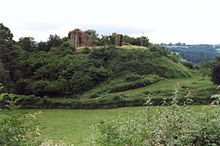- Clifford Castle
-
Clifford Castle is a castle in the village of Clifford which lies four miles to the north of Hay-on-Wye in the Wye Valley in Herefordshire, England (grid reference SO243457).
Contents
Early Norman castle and planned settlement
The early motte and bailey castle was built on a cliff overlooking a ford on the River Wye in 1070 by William FitzOsbern. The castle was intended to provide protection for a planned Norman settlement above the River Wye of quite a substantial size, with c. 200 plots being intended, running uphill for half a mile towards Llanfair, where the church was sited on the hilltop. St Mary's church remains today, much altered in the Victorian era. It has a wooden 13th century effigy of what appears to be a clerical figure. It has been said to resemble another effigy, of Bishop Peter of Aigueblanche, in Hereford Cathedral.
A short distance downhill from Llanfair is Priory Farm, built on the site of a Cluniac Priory, believed to have been founded in 1130. Priory Farm is a very substantial farm building and presumably used much of the stone already on the site in its construction. It is also surrounded by stone wall field boundaries.
In the Domesday Survey the settlement was recorded as Cliford. Maps from three centuries later show Herefordshire having three significant settlements; Hereford, Wigmore and Clifford.
The position of the castle adjacent to the River Wye enabled the seasonal flooding of the river to fill the flood plain around the castle, forming a shallow lake or marsh with the assistance of a dam on the western or upstream side of the site.
Changing hands
When his heir, Roger de Breteuil, 2nd Earl of Hereford, forfeited his lands for rebellion against the King in 1075, the castle was granted to Ralph Tosny who held it directly from the Crown. From Ralph, it passed to his son-in-law Richard des Ponts (more correctly Richard Fitz Pons). Richard's son Walter Fitz Richard later took the name of Walter de Clifford after he seized the castle from its Tosny overlord before 1162. Much of the stone castle would seem to have been built before 1162 as it much resembles the Tosny Conches Castle in Normandy.
The King's mistress
Clifford Castle was the home of Walter Fitz Richard's daughter Rosamund Clifford, who was also known as the Fair Rosamund. She was the mistress of Henry II until her death in 1176 or 1177 when she was buried at Godstow in Oxfordshire. A property near the castle is called Rosamund House today.
The Clifford Rebellion
In 1233 Walter III de Clifford the grandson of Walter Fitz Richard rebelled against the autocratic rule of King Henry III. In early September the king came and besieged Clifford castle, forcing the garrison to surrender after just a few days. Walter Clifford then made his peace with the Crown and led his troops against Prince Llywelyn ab Iorwerth his father-in-law. Walter's volte-face was even more disreputable as Prince Llywelyn had just entered the field to fight the king in support of Walter. Twenty years later Walter nearly rebelled again, when, in a fit of anger, he forced a royal messenger to eat a royal writ, together with the royal wax seal the size of a dinner plate. For this Walter lost many of his Marcher Lord privileges.
The ruins
Clifford castle now consists of a great motte as constructed by the men of William Fitz Osbern in the late 1060s. This was later sub-divided and the eastern part was crowned by an ovoid shell keep with five D-shaped towers in its circuit. Its north wall appears to overlie part of William Fitz Osbern’s original hall. To the east of the motte is the castle bailey. Most of the walls of this structure have disappeared, but centrally are the remains of a great twin-towered gatehouse probably of the mid-thirteenth century. To the west of the castle is a broken earthwork dam which would have flooded the valley to the south of the castle. With the River Wye to the north the fortress would have been surrounded by water on all sides except for the east. As such it would have been a very difficult fortress to take by storm. Clifford Castle is within the grounds of a family home and has no public access.
Destruction
During the rebellion of Owain Glyndŵr the castle was destroyed in 1402 by Welsh forces.
Modern ruin
Since its last use in the 15th century it has fallen into ruins with much of the stone pillaged for the older properties seen in the village today. Large dressed stone blocks can be seen in garden walls. As the present owners have failed to upkeep in the castle in line with the low key maintenance routine suggested by English Heritage, the condition is deteriorating and a long-term repair strategy is desperately needed, especially for the tower. The castle is, as a result, currently on the English Heritage Heritage At Risk Register 2010
References
- Remfry, P.M., Clifford Castle, 1066 to 1299 (ISBN 1-899376-04-6)
- Fry, Plantagenet Somerset, The David & Charles Book of Castles, David & Charles, 1980. ISBN 0-7153-7976-3
External links
Categories:- Castles in Herefordshire
- Ruins in Herefordshire
- Grade I listed buildings in Herefordshire
Wikimedia Foundation. 2010.

